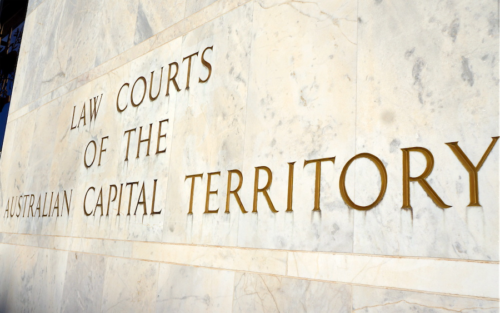The letters keep rolling in; thank you to all our readers…
THE letter by Stephen James (CN August 19), poses questions about housing affordability in Canberra and how attractive it is for investors to own property here.
 I believe the ACT government is by far the most hostile jurisdiction to investors in the country and by a very long way. How could this not affect supply when there are so many other attractive markets across Australia and with a much friendlier jurisdiction for investors in NSW on our doorstep?
I believe the ACT government is by far the most hostile jurisdiction to investors in the country and by a very long way. How could this not affect supply when there are so many other attractive markets across Australia and with a much friendlier jurisdiction for investors in NSW on our doorstep?
Whether it is an ideological loathing of investors, seeing them as a cash cow to be milked or a misguided assumption that by being overly biased in favour of renters will result in more favourable outcomes for them, the outcome is that rental property stock is reduced and rents increase – supply and demand in action.
Land tax impositions (and units/apartments now treated similarly to detached housing for valuation purposes for rates) already make owning a rental property in the ACT a dubious proposition, but when you add into the equation the blatant bias in favour of renters and a seemingly never ending quest to water down landlords’ rights (ie the ACT already has the longest notice to vacate period in the country at six months – but the ACT government wants to increase this to a staggering 12 months) then no wonder the resulting lack of rental stock.
I have owned an ACT rental property for several years and it has been one of the most unpleasant, stressful experiences of my life.
Renters know they are a sacred cow in this jurisdiction and the ever increasing rates/land tax costs of almost $2000 every three months only adds insult to injury.
The ACT government appears to view property investors as a charity to provide rental stock to supplement their failed policies with public housing.
Buying an investment property two years ago in regional NSW has been a surprisingly pleasant and rewarding experience – I would never even consider buying in the ACT again.
I would be far from the only investor with this view and this results in less rental stock and higher rents – the extraordinarily low vacancy rates in the ACT (0.08 per cent with Tuggeranong at just 0.02 per cent) show the ACT government and its Tenancy Tribunal need to rethink their adversarial approach to property investors.
Recent rampant property price growth means more and more Canberrans will never be able to afford to own their own home, such a dire rental situation reduces quality of life and the financial situation for a great number of people – the ACT government is only hurting the people they are supposedly trying to help.
Jimmy Savitsky, Richardson
Stop the lockdown
I AM writing on behalf of all Canberrans. I urge you to petition the Chief Minister to end these draconian lockdowns before our city is destroyed. They don’t help and the economic, social and mental consequences will be immense. You can’t vaccinate away the effects of the lockdowns.
Pete Locke, via email
Lucinda’s ‘harsh and uninformed’
WHO would have thought that in 2021 in Canberra I’d read such a harsh and uninformed letter (CN September 2) such as that from Lucinda Spier, of Campbell. It is clear that Lucinda has little knowledge of public-housing tenants beyond the stereotype of “welfare-cheating low lifes”. She has passed judgement and assumption onto the new residents of her street based on the fact it’s public housing.
The writer makes the claim that “the vast majority of public housing tenants are on Commonwealth benefits”.
Ignoring the lack of substance to this claim, I’d be interested if Lucinda knows the current rates of any Commonwealth benefits? The current rate of JobSeeker is about $620 a fortnight for a single person. Rent assistance for a single person is in the vicinity of $130 a fortnight. The current averaged rent for a one-bedroom property in the ACT rental market is $425 a week. This means that someone would spend 117 per cent of their gross weekly income on a private rental in Canberra. I’m sure Lucinda can see the issue here.
What she clearly shows no empathy for is the array of complexities and issues that are over-represented in public-housing tenants. Public-housing tenants are more likely to have a long-term disability. Are more likely to have a lived experience of trauma and mental illness. They are often being housed after an extended period of homelessness. Add in low income and Lucinda wishes for them to pay for rates (on property already owned by the government?) and for garbage collection.
Public Housing tenants pay indirect taxes through car registration and GST. They pay for their energy utilities. Many hold down a part time or casual job, and some work full time – paying direct taxes as they go. Lucinda shows her true prejudice when she doesn’t consider that those who rent privately don’t pay a cent towards rates or garbage collection either.
Her final remark that “once a person gets public housing they cease to be needy and should make a contribution to Canberra” is based on a completely false premise.
Housing is not the solution to everyone’s problems, but it is an essential need that can provide the avenue for a solution to other presented needs.
The “vast majority” of public housing tenants contribute to their communities in various ways – they volunteer, they check in on neighbours, they send their children to local schools, and are often at the forefront of community activities such as free pantries.
I challenge Lucinda to get out there and meet some public housing tenants instead of living her life by a series of stereotypes and generalisations.
James Ellis, Spence
Conflicted by tobacco connection
MY past is catching up to me! I can’t remember walking out of the advisory Assembly in the ‘80’s, as Alan Shroot claims (Letters, CN September 2) on banning tobacco advertising, however I hope I did as there was a conflict of interest with my connection to a tobacco industry client.
The difference then (and still now) is that tobacco was/is a legal product whereas illicit drugs are not, which I regard as another inconsistency shared with Dr. Shroot.
Greg Cornwell, Yarralumla
Packing more sardines into the tin
CONGRATULATIONS Michael Moore on an excellent article (“Pandemic reveals the price of packing people in”, CN September 2).
I do hope our Chief Minister, who as per his “Statement of Ambition” of 2016 is attempting to turn Canberra into a “compact and vibrant city”, reads it.
One means of “city building” is the light rail and large sums of our taxes and rates are spent on getting the extension from Civic to Woden underway.
The light rail will take 30 minutes to cover the distance for which buses (very soon similarly operating CO2-free) take 15 minutes normally and 16 minutes during rush hour.
However, the light rail has the great advantage for developers that the area around stops will provide the ideal environment for high-rise as it has along Northbourne Avenue.
Or, to put it pictorially, more sardines can be packed into the tin. More rates from the many in the high-rise, plus a steep climb in land prices for the government to profit.
Why worry that compact housing provides the ideal breeding ground for covid? Why be concerned that Canberra has declared a climate emergency in May 2019 and the infrastructure for the light rail extension will produce massive amounts of greenhouse gases? Why bother to point out that compact housing creates heat islands raising summer temperatures up to five degrees?
This development of unspecified cost might well be leaving insufficient funds for health, education and housing, but it is, after all, in the interest of progress!
BM Bodart-Bailey, via citynews.com.au
Stay away from me, too!
CHEER up, Mario (“Stay away from me!”, Letters, CN September 2). Mr Stivala, I can only presume that you are unvaccinated yourself, otherwise why give consideration to the status of others? Have your jab, be comfortable in your assumed protection and, please, with such a woebegone attitude like yours, stay away from me, too.
Michael Stachow, Giralang
Jono needs to do his homework
I AM pleased to see young Greens MLA Johnathan Davis taking an interest in sport (“Davis drives government to look at fair funding”, CN August 26), but he really needs to do his homework first.
Indeed, he’s scored an own goal by calling for the establishment of “a sport and recreational industry peak body to support the (sport and rec) sector.”
Err Jono, mate, sorry to disappoint you but we had one from 1990 – ACTSport, which I founded on behalf of the then Alliance government and local sporting legends, the late Harry Marr and Jim Roberts, of Sports House Hackett fame.
It did a great job representing the ACT Sport and Recreation industry from 1990 to 2015.
Unfortunately, it was Jono’s boss Shane Rattenbury who abolished ACTSport in 2015 when he was Minister for Sport.
When I was Minister for Sport, we also used to give triennial grants to sporting bodies so that there was certainty of funding and to ensure it would not just be given on an ad hoc basis.
There were three categories; the first for the larger mass participation bodies such as basketball, softball, football, rugby, cricket, swimming etcetera, the second category for less popular sports and a third category for smaller sports still. We also had specific one-off grants for a variety of things such as projects and equipment.
Are you telling me, Jono, your Greens/Labor predecessors have got rid of these triennial grants, too?
Despite several own goals here (I like your U10 story, too, Jono), I am happy to give Mr Davis the benefit of the doubt in assuming that he genuinely wants to help sport in the ACT.
To that end, I’d urge him to get his own government to reinstate ACTSport and triennial funding for all ACT sporting bodies. While he’s at it, he could also get his government to save Kippax Oval from development, or if he can’t do that, at least bring back the three or four old playing fields lying fallow at the Higgins end of the current ovals.
Bill Stefaniak, Minister for Sport, 1989-1991 and 1995-2001
History lost to a house
THE destruction of the house at 22 Brockman Street, Narrabundah is, as columnist Paul Costigan notes (CN August 26), a sad event.
The house was built for Heather and Val Paral. Heather owned Studio 12 at Manuka while her husband Val was the photographer who took the “Faceless Men” photographs in 1963.
I found out about Val’s previously hidden role when researching a biography of the journalist Alan Reid.
Stephen Holt, Macquarie
Robyn is right about mynas
JOHN Franza (Letters, CN August 26) admits that he has personally killed many Indian mynas. It is understandable that he feels the need to justify himself.
However, Robyn Soxsmith (Letters, CN August 12) is right. Indian mynas are a symptom, not a cause of the crisis facing our native wildlife. Hundreds of millions of native animals have been killed, and are still being killed, by both direct slaughter and habitat destruction, to make way for settlement and agriculture.
In any case, myna numbers are not controlled by killing programs, but by fluctuations in environmental conditions. As Ms Soxsmith mentioned, mynas are fast-breeding animals. They cannot be eradicated. Every bird killed merely leaves space for at least one of four new ones to grow up and take its place.
As for kangaroos, assertions about kangaroos overpopulating and starving are just pleasant little fairy tales people tell themselves so they can sleep at night while their local kangaroos are being gunned down. The government’s claim that the kangaroo killing is to protect either the environment or the kangaroos was debunked in 2014 when the CSIRO found that kangaroos enhanced the ecological health of the ACT reserves, and were not present on them in numbers that harmed the environment in any way.
Frankie Seymour, Queanbeyan
What wine with what fish?
IN his column, wine writer Richard Calver asks the rhetorical question “What wine goes best with fish and meat?” (CN August 26).
That’s a tough one, especially without the type (or types) of “meat” not being specified. Since there are so many types and forms of meat, ranging from sausages to grilled rump steak, I’ll stick with discussing fish: otherwise this letter could go on (almost) indefinitely.
Having been a professional wine taster and writer for about 12 years, I have experienced a huge range of wines, mostly from Australia, France, Italy and the US, and have tried many of them with a wide range of food.
My favourite pairing with full-flavoured fish, such as snapper or salmon, is a semillon-sauvignon blanc from Margaret River (WA), a rich, oaked chardonnay, or a dry – preferably Provence (French) – rosé, which is a marvellous match with salmon.
A more delicately flavoured fish, such as whiting, is a great pairing with lighter-bodied white wine, such as riesling. Finding a food match for fuller-bodied sauvignon blanc (again from Margaret River) is not easy – but smoked trout would come close.
Douglas Mackenzie, Deakin
Time for a National War Museum
ANZAC Hall at the National War Memorial has gone, and the proposed southern extensions of the complex, shown in the current Works Approval Application to the National Capital Authority, are destructive of the Memorial’s fine architectural design and heritage.
The problematic and confusing duality with regard to the main southern entrance, described below, is perpetuated and accentuated in the current design proposal.
The physical functional arrangement of the existing National War Memorial, as a combined cenotaph and war museum, has never really been satisfactory.
The central dominant section is a very fine cenotaph, with towering twinned portals, colonnaded galleries, reflecting pool and magnificent elevated central dome; and the cenotaph’s arrangement complies with the architectural principle of “form follows function”.
However, the side display components are not so successful in that regard, and their functions are somewhat forced into their architectural forms.
Public access to them is not clearly identifiable, and the internal circulation arrangement is less than satisfactory. Nevertheless, those side, or “saddlebag” components contribute to the overall symmetrical architectural arrangement.
The profligate demolition of the fine new Anzac Hall, and the proposed installation of a massive “theme-park” component, at the rear of the complex, was and remains architectural vandalism and will not improve the existing circulation problems.
That scheme should be scrapped, and its funds allocated to a new purpose-built National War Museum, including indigenous elements.
It could be built at an evocative place elsewhere in the Central National Area, such as at Yarramundi Reach opposite the popular National Arboretum. The new NWM would reveal many important military and related items, currently rarely seen by the public.
Jack Kershaw FRAIA (retired), Kambah
Statues aren’t the answer
INDEPENDENT ACT Senate candidate Kim Rubenstein has started a campaign to push for more statues of women in Canberra.
Seeing that the PM recently announced that bronze sculptures of the first two women elected to federal parliament, Dame Edith Lyons and Dame Dorothy Tangney, have been ordered, hasn’t Ms Rubenstein got anything more important to say?
If she’s serious about standing as an ACT Senate candidate at the upcoming federal election, she would be well advised to indulge in something more substantial than mere tokenism in her quest.
Mario Stivala, Belconnen
Protecting our homeland
I THINK it’s time Australians realised that COVID-19 is like a large lava flow. No country has been able to stop such a flow in the desired time. Both bring morbidity and mortality virtually at will, as they seem to have a mind of their own. Lava-affected countries have had to learn to live with this natural enemy.
As for attempted human remedies, opening the borders too soon seems illogical. India, seven south-east Asian countries and China have more than three billion people, many of their nationals having a history of entry as visitors and temporary or permanent residence.
Just as the vaccines available in Australia had to pass the most stringent tests before use, how can Australia hope to have countries meet the strictest Australian criteria pre-departure for those who will seek entry to this land – including all the COVID-19 health-support structures in those countries?
COVID-19 aside, one only has to watch the TV border control series to know the huge difficulties facing protection of our homeland.
Colliss Parrett, Barton
Who can be trusted?
In a world of spin and confusion, there’s never been a more important time to support independent journalism in Canberra.
If you trust our work online and want to enforce the power of independent voices, I invite you to make a small contribution.
Every dollar of support is invested back into our journalism to help keep citynews.com.au strong and free.
Thank you,
Ian Meikle, editor





Leave a Reply